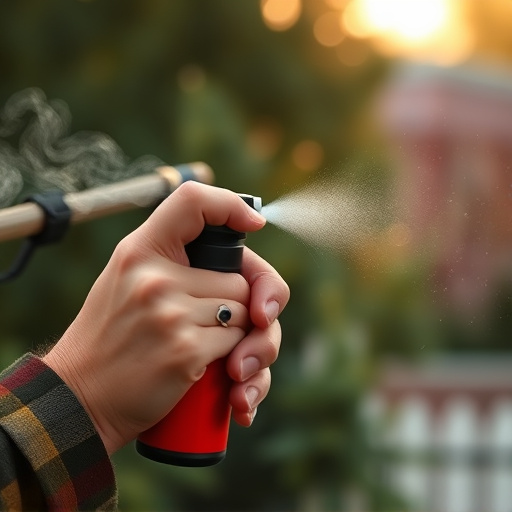Specialized training (Pepper Spray Defense Training Tips) is crucial for law enforcement to safely and effectively deploy pepper spray. This involves learning aiming techniques, handling practices, and de-escalation methods to prevent harm while incapacitating suspects. Regular practice with simulated scenarios and advanced training methods enhance accuracy and safety during high-pressure situations, ensuring responsible use of pepper spray equipment.
“Enhance your understanding of law enforcement pepper spray equipment and unlock vital defense techniques. This comprehensive guide delves into the fundamentals, safe handling practices, and effective strategies. From basic knowledge to advanced training tips, master optimal performance with our expert insights. Discover key procedures for storage, and learn defensive moves to ensure preparedness. Empower yourself with these pepper spray defense training tips for enhanced on-duty safety.”
- Understanding Pepper Spray Equipment Basics
- Safe Handling & Storage Procedures
- Effective Pepper Spray Defense Techniques
- Training Tips for Optimal Performance
Understanding Pepper Spray Equipment Basics
Pepper spray equipment is a critical tool for law enforcement officers, providing a non-lethal means to subdue and control suspects. Understanding the basics of this equipment is essential for effective deployment and officer safety. Pepper spray, also known as oleoresin capsicum (OC) spray, is a potent irritant derived from chili peppers. It disrupts nerve signals in the eyes, nose, and respiratory system, causing temporary blindness, coughing, and difficulty breathing.
Pepper spray defense training tips emphasize proper handling and application techniques. Officers should be trained to aim for the face, specifically the eyes, as this area is most sensitive to OC spray. Correct usage involves a quick burst of spray followed by a safe distance, allowing the irritant to take effect without endangering bystanders or officers themselves. Regular practice sessions can help law enforcement professionals become proficient in deploying pepper spray equipment effectively and responsibly.
Safe Handling & Storage Procedures
Proper handling and storage of pepper spray equipment are crucial components of law enforcement procedures, especially during high-stress situations. Officers must receive adequate training on safe handling practices to ensure their own well-being and prevent accidental discharge. This includes understanding the unique characteristics of each spray canister, such as trigger mechanisms and safety features, which can vary between models.
Storage involves keeping pepper spray out of reach from unauthorized individuals while maintaining its integrity. Law enforcement agencies should establish clear protocols for secure storage, including designated areas with controlled access, regular inventory checks, and proper labeling to identify contents and expiration dates. Following these safe handling and storage procedures not only ensures the effectiveness of the equipment but also promotes responsible and efficient law enforcement operations.
Effective Pepper Spray Defense Techniques
Pepper spray is a powerful tool, but its effectiveness relies on proper handling and technique. Effective Pepper Spray Defense Training Tips include understanding the spray’s range and duration, as well as learning to time and aim accurately. Officers should practice deep breathing exercises before deployment to maintain composure and clear vision.
During encounters, positioning is key; keeping distance allows for better control and prevents accidental exposure. Targeting the eyes and face, often vulnerable areas, can incapacitate an individual quickly. Additionally, training should emphasize de-escalation techniques, as pepper spray should be a last resort, used only when necessary to control a situation or ensure officer safety.
Training Tips for Optimal Performance
Effective Pepper Spray Defense Training Tips are essential for law enforcement officers to ensure optimal performance in high-pressure situations. Regular simulated scenarios that mimic real-world encounters can significantly enhance an officer’s ability to deploy pepper spray accurately and safely. During training, it’s crucial to emphasize proper hand placement, target acquisition, and understanding the spray’s range and de-escalation strategies. Officers should also practice different techniques for various subjects, including those with physical disabilities or unusual stances.
Incorporating advanced training methods, such as virtual reality simulations and role-playing exercises, can further refine an officer’s skills. Additionally, continuous education on the latest pepper spray models, their unique features, and decontamination procedures is vital. By combining practical drills with theoretical knowledge, law enforcement agencies can equip their officers with the necessary Pepper Spray Defense Training Tips to handle diverse scenarios effectively while prioritizing safety for both the officers and the public.
Pepper spray equipment is a valuable tool in law enforcement, but proper understanding and training are essential for effective deployment. By mastering safe handling, storage, and defense techniques, officers can ensure their pepper spray remains a potent asset. Incorporating regular training sessions with strategic tips will optimize performance, enhancing the overall efficiency of pepper spray defense tactics within law enforcement agencies.
